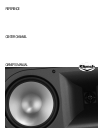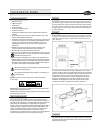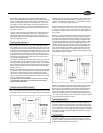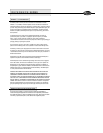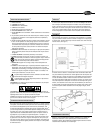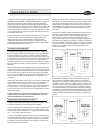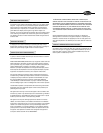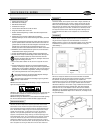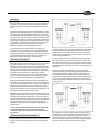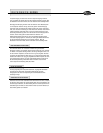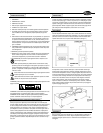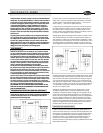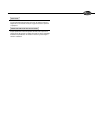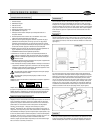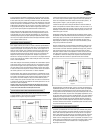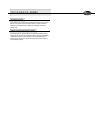
Klipsch Reference Series speakers are wired internally with Bandwidth Balanced
™
M o n s t e r
®
Cable. Bandwidth Balanced technology employs multiple gauges of high-purity
copper wire, carefully selected and wound to ensure optimum signal transfer at all fre-
quencies. You will obtain best performance from your speakers if you connect them to
your amplifier or receiver with Monster Cable or similar quality wire available from your
dealer. We recommend that you use 16-gauge or heavier stranded copper wire. Use a
lower gauge (heavier) wire for longer runs to reduce the amount of amplifier power lost
due to the wire’s resistance.
On the back of each speaker are two sets of binding posts, one feeding the tweeter and
the other the woofers. For conventional wiring, these sets are connected together with
gold-plated metal straps, which must be removed for bi-wiring or biamping. We will
explain ordinary single-wiring first and then the alternatives. All the information regarding
single-wiring also applies to bi-wiring.
BUT FIRST: TYPES OF CONNECTORS
Bare wire. Pull the two conductors apart for about an inch and strip approximately 1/4-
inch of insulation from the end of each. (A wire stripper will simplify this, but you can use
an ordinary pocket knife to cut around and through the insulation down to the wire.) Twist
the strands of wire on each individual conductor tightly together. Loosen the nuts on a pair
of binding posts until the holes through the metal posts are exposed, then insert the bare
wire through the holes. Screw the nuts down finger-tight on the wire. Make sure that no
strands of wire are touching from one binding post to the other or to any strands from the
other conductor. Failure to observe this precaution at either end of the connection can
result in amplifier malfunction or damage.
Pins. Many pre-made speaker cables are terminated with metal pins. Loosen the nuts on a
pair of binding posts until the holes through the metal posts are exposed, then insert the
pins through the holes. Screw the nuts down finger-tight on the pins — do not overtighten.
Make sure that there is no metal-to-metal contact between the two pins or binding posts.
Failure to observe this precaution at either end of the connection can result in amplifier
malfunction or damage.
Spade lugs. Some speaker cables are terminated with U-shaped connectors called spade
lugs. Loosen the nuts on a pair of binding posts and slip the spade lugs around the metal
posts. Screw the nuts down finger-tight on the lugs and inspect to ensure they have
remained firmly in place. Make sure that there is no metal-to-metal contact between the
two lugs or binding posts. Failure to observe this precaution at either end of the connection
can result in amplifier malfunction or damage.
OTHER TYPES OF SPECIALTY CONNECTORS ARE AVAILABLE TO FACILITATE HOOKING
UP YOUR SPEAKERS. PLEASE CONSULT YOUR AUTHORIZED KLIPSCH DEALER FOR
SUGGESTIONS AND FURTHER DETAILS.
SPEAKERS TO AMPLIFIER: KEEPING IT STRAIGHT
One of the most important things about hooking up your speakers is keeping them in the
same polarity, or phase. If they are connected out of phase, bass and sound imaging will
be degraded.
The easiest way to ensure that your speakers are wired in phase is to always
connect the positive and negative output terminals on your amplifier or receiver to the
matching input terminals on your speakers: positive (“+”, color-coded red) to positive and
negative (“–”, color-coded black) to negative. (See Figure 3.)
Most pre-terminated speaker cables have color-coded connectors that make it easy
to match output and inputs correctly. If yours do not, or if you are making your own
out of paired, two-conductor wire, look for identifying marks on the insulation of the
two conductors. Normally there will be printing, a stripe or a molded ridge along one
of the conductors.
Bi-wiring - In bi-wiring, separate cables are connected from the amplifier or receiver out-
put terminals to the speaker input terminals for the tweeter and woofers. (See Figure 4.)
This results in lower electrical resistance between the amplifier and speaker than single-
wiring with the same gauge cable. In some cases bi-wiring may be preferable to single-
wiring with lower-gauge cable, which will be thicker and probably less flexible. To bi-wire
your Reference Series speakers, loosen the nuts on the binding posts and remove the
metal straps linking the woofer and tweeter terminals. Observing proper polarity, connect
one cable to the tweeter binding posts (upper) and another to the woofer binding posts
(lower). Run both cables back to your amplifier or receiver and attach them to the same
channel. (Do not, for example, attach one to an A speaker output and the other to a B
speaker output on an amplifier or receiver with A/B speaker switching.) Amplifiers may be
severely damaged if straps are not removed.
Biamping - In biamplification, the tweeter and woofers are driven by separate amplifiers
fed from the same preamplifier output. We do not recommend biamplifying any of our
speakers, since in general it will produce no benefit that could not be obtained simply by
using a single larger amplifier and may cause severe sound degradation if not done
properly. If you do biamplify, use the same model amplifier for the tweeter and woofer
sections (to prevent frequency-response errors caused by different amplifier gains) and be
sure to remove the straps linking the two sets of input terminals on the speaker. Amplifiers
may be severely damaged if straps are not removed.
BASS MANAGEMENT SETTINGS
Surround-sound receivers and processors use what is known as bass management to
ensure that low frequencies in the various channels are sent to speakers that can handle
them well and away from small speakers that cannot. Any of the Klipsch Reference Series
center-channel speakers can be set to Large in your receiver or processor’s speaker setup
menu if necessary. But if your system includes a good powered subwoofer or floorstanding
left and right front speakers, you probably will get better overall performance by using the
Small setting for the center.
CARE AND CLEANING
The only thing you should ever need to do to your speakers is dust them occasionally.
Never apply any abrasive or solvent-based cleaner or any harsh detergent. You can clean
the grilles with the brush attachment of a vacuum cleaner.
Figure 3
Figure 4



